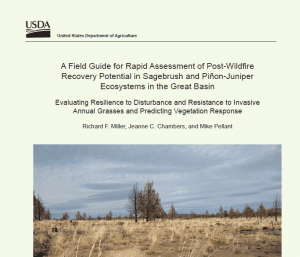Research and Publications
View abstracts.
Abstracts of Recent Papers on Climate Change and Land Management in the West, Prepared by Louisa Evers, Science Liaison and Climate Change Coordinator, BLM, OR-WA State Office.
View research brief.
This study shows that conifer removal for sage-grouse also benefits sagebrush-dependent songbirds. In the Warner Mountains of southern Oregon, Brewer’s sparrow abundance increased by +55% and green-tailed towhee jumped +81% following cuts. Annual increases each year post tree removal suggest that songbird use may increase even more with time. Abundances of species less dependent on shrublands including mountain bluebird and rock wren were unaffected by treatments.
View abstracts.
Abstracts of recent papers on climate change and land management in the West. Prepared by Louisa Evers, Science Liaison and Climate Change Coordinator, Bureau of Land Management, Oregon-Washington State Office.
View abstracts.
These abstracts of recent papers on rangeland management in the West were prepared by Charlie Clements, Rangeland Scientist, USDA Agricultural Research Service, Reno, NV.
View article.
This study evaluated the effects of fire on biological soil crusts of early-seral juniper. Compared with unburned plots, the biomass of cyanobacteria was diminished under juniper and sagebrush; it was reduced in the interspaces in both burned and unburned plots, presumably in response to generally harsher conditions in the postburn environment. Nitrogen fixation rates declined over time in juniper plots and interspaces but not in sagebrush plots. Although fire negatively affected some biological soil crust organisms in some parts of the early-seral juniper woodland, the overall impact on the crusts was minimal. If the intent of burning is to reduce juniper, burning of early-seral juniper woodland is appropriate, as most affected trees were killed. Burning early-seral juniper may be preferred for controlling juniper encroachment on rangeland.
View report.
This report documents the growth over the past 20 years of the portion of the Forest Service’s budget that is dedicated to fire, and the debilitating impact those rising costs are having on the recreation, restoration, planning, and other activities of the Forest Service.
As more and more of the agency’s resources are spent each year to provide the firefighters, aircraft, and other assets necessary to protect lives, property, and natural resources from catastrophic wildfires, fewer and fewer funds and resources are available to support other agency work—including the very programs and restoration projects that reduce the fire threat.
View article.
This study tested the stress-gradient hypothesis (SGH) in observations of 75 sites along overlapping water and heat stress and disturbance gradients. As stress-disturbance levels increase, sagebrush-herbaceous plant facilitation levels increase, the landscape will become increasingly aggregated as a product of necessary facilitation between sagebrush and herbaceous plants. This aggregation decreases the individual resilience of the native herbaceous plants, increases the competition from invasive plants, and decreases the overall stability and resilience of the sagebrush steppe ecosystem.
View article.
This study used survey data from three 2010 wildland fires to understand how ecological knowledge and education level affected fire management perception and understanding. Results indicated that increased accuracy in identifying ecological conditions was associated with higher proficiencies in the identification of fire management strategies used for wildfires. Education levels were not significantly related to public perception of fire management but were related to significant differences in accurately identifying ecological conditions. Results suggest that education may play a mediating role in understanding complex wildfire issues but is not associated with a better understanding of fire management.
View field guide.
This field guide provides a framework for rapidly evaluating post-fire resilience to disturbance, or recovery potential, and resistance to invasive annual grasses, and for determining the need and suitability of the burned area for seeding. The framework identifies six primary components that largely determine resilience to disturbance, resistance to invasive grasses, and potential successional pathways following wildfire, as well as the information sources and tools needed to evaluate each component.
The components are: (1) characteristics of the ecological site; (2) vegetation composition and structure prior to the wildfire; (3) fire severity; (4) post-wildfire weather; (5) post-wildfire management, especially grazing; and (6) monitoring and adaptive management.
The tools provided are: (1) a conceptual model of the key components that largely determine resilience to disturbance and resistance to invasive annual grasses of the burn area, (2) a guide to evaluate post-wildfire severity, (3) indicators to estimate pre-wildfire plant composition and structure if not known, and (4) an evaluation score sheet to rate an area’s potential post-wildfire resilience to disturbance, resistance to invasive annual grasses and, thus, the need for seeding and probability of success.
View abstracts.
These abstracts of recent papers on rangeland management in the West were prepared by Charlie Clements, Rangeland Scientist, USDA Agricultural Research Service, Reno, NV.


